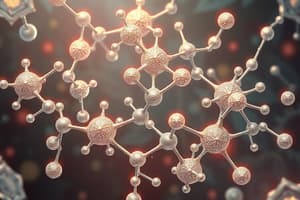Podcast
Questions and Answers
What is the major difference between the A-form and B-form helices?
What is the major difference between the A-form and B-form helices?
- A-form helix is right-handed, while B-form helix is left-handed
- A-form helix has a narrower, elongated structure compared to the B-form helix
- A-form helix has a deeper, narrower major groove than the B-form helix (correct)
- A-form helix has a wider, more accessible major groove than the B-form helix
Under which conditions does the Z-form of DNA typically form?
Under which conditions does the Z-form of DNA typically form?
- Under high salt concentrations (correct)
- Under physiological conditions
- Under nonphysiological conditions
- Under low salt concentrations
What feature distinguishes an A-DNA helix from other DNA forms?
What feature distinguishes an A-DNA helix from other DNA forms?
- Right-handed structure
- Shorter distance per complete turn
- Formation under physiological conditions
- Presence of a 2′ hydroxyl group on the ribose sugar (correct)
What type of base pairs can be found in a hairpin RNA secondary structure?
What type of base pairs can be found in a hairpin RNA secondary structure?
Which form of DNA has a pitch of 3.2 to 3.4?
Which form of DNA has a pitch of 3.2 to 3.4?
What characteristic makes the B-form DNA more accessible to proteins compared to the A-form DNA?
What characteristic makes the B-form DNA more accessible to proteins compared to the A-form DNA?
In what direction does the hairpin RNA strand loop back to form a stem?
In what direction does the hairpin RNA strand loop back to form a stem?
'Highly-developed secondary structure in RNA due to intramolecular base pairing' is associated with which figure?
'Highly-developed secondary structure in RNA due to intramolecular base pairing' is associated with which figure?
Flashcards are hidden until you start studying



